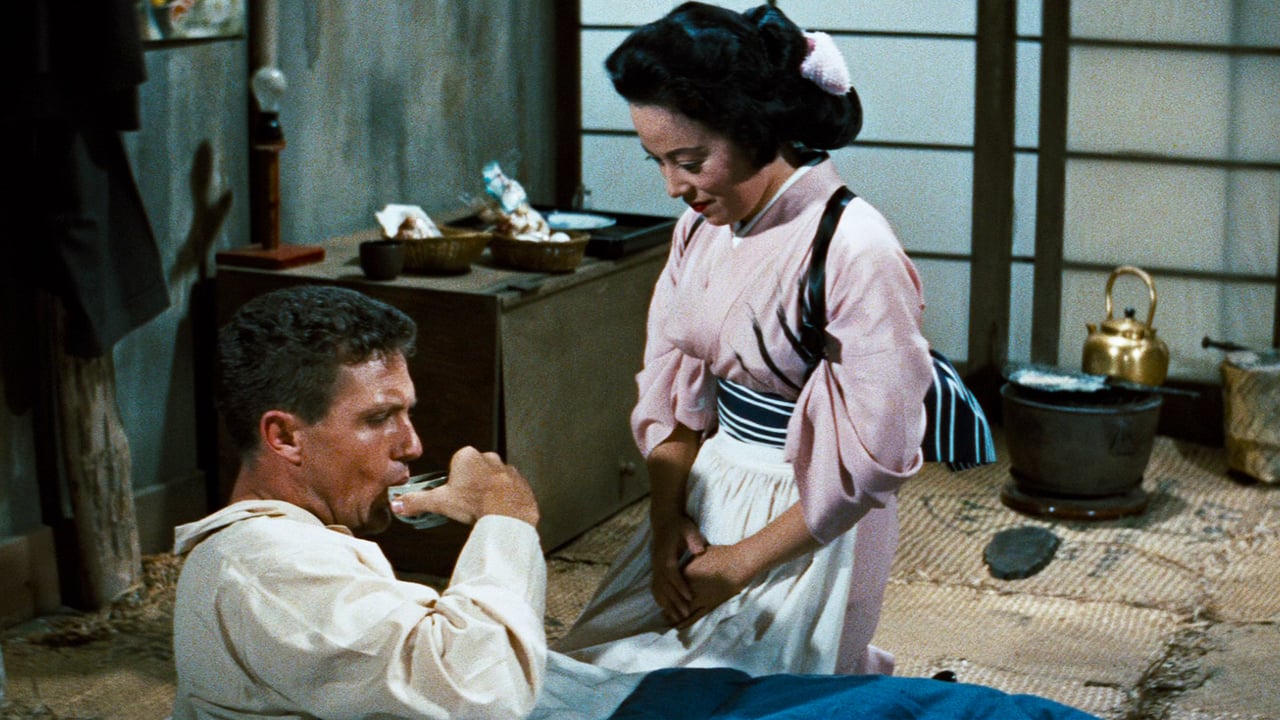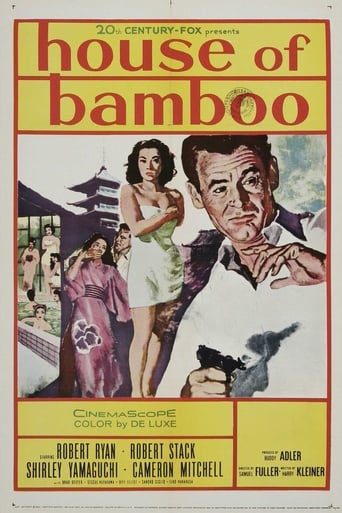

Too much about the plot just didn't add up, the writing was bad, some of the scenes were cringey and awkward,
... View MoreThe best films of this genre always show a path and provide a takeaway for being a better person.
... View MoreThis is one of the best movies I’ve seen in a very long time. You have to go and see this on the big screen.
... View MoreYes, absolutely, there is fun to be had, as well as many, many things to go boom, all amid an atmospheric urban jungle.
... View MoreDishonorably discharged Ex-US army soldiers run a crime ring in post WW2 Tokyo. Led by Sandy Dawson (Robert Ryan), they, perhaps mistakenly, kill an active duty soldier during a job they pull as the film opens. Robert Stack plays an army agent sent over to infiltrate the ring, a group of army rejects memorably led by Robert Ryan. The finale is a totally gripping roof- top chase high over Tokyo's crowded streets. The film captures a sense of Japanese life and has impressive cultural depth, probably thanks to ace director and writer Sam Fuller. The idea itself of dishonorable discharges forming a crime ring in Tokyo is fairly well inspired, and is taken into impressive detail as the some of the guys in the gang try to be the ichi ban or number one next to Robert Ryan. Ryan has seldom looked better, capturing a smug sense of control with underlying ruthlessness. Stack as the army's secret agent, isn't bad either.
... View MoreHouse Of Bamboo came out in 1955 three years after the Japanese Peace Treaty effectively ended the occupation of Japan that began post World War II. Americans must have been familiar sight on the streets of Japanese cities still in 1955, we certainly had enough military personnel there. If you don't recognize that fact than you will be puzzled as to how a gang of Americans crooks could operate the way they do in the streets of Tokyo.For those of you who don't recognize it screenwriter Harry Kleiner took the screenplay he wrote for the Henry Hathaway classic, The Street With No Name and set in down in post occupation Japan. Robert Ryan plays the gang leader part that Richard Widmark had. He's recruited a gang of former military misfits who spent more time in the stockade than in combat and made them into an effective heist gang. Ryan's got other interests, but his main income is from some well planned robberies.The USA military intelligence gets involved when Ryan hijacks a train with military hardware and kills a soldier. Going undercover is Robert Stack in the Mark Stevens part. Unlike The Street With No Name, Stack's allowed a little romance here in the person of Japanese actress Shirley Yamaguchi. In The Street With No Name it was Widmark who had the girlfriends and Stevens was strictly business. Sessue Hayakawa is also in the cast as the Japanese police inspector.There's a gay subtext in the film with the relationship of Ryan with his number two, Cameron Mitchell. When Stack starts to take his place in the gang hierarchy, Mitchell reactions are of pure jealousy. In fact Mitchell's reactions are what sets in motion the climax of the film.Which you know if you've seen The Street With No Name. House Of Bamboo boasts some mighty nice location shots of postwar Tokyo which looking at it you would hardly believe what a difference a decade might make. The title House Of Bamboo is the place that Ryan lives in and it's a pre-war structure typical of the Tokyo before General Doolittle inaugurated US bombing raids. Those wooden houses went up like tinder boxes. Note the more modern look Tokyo has in 1955.The color might disqualify House Of Bamboo from the genre, but the film as the look and feel of a good noir film. Which is as good a recommendation as I can give it.
... View MoreHOUSE OF BAMBOO is a film from the early part of director Sam Fuller's career. Despite the director having a reputation for shooting a film very, very quickly, this film looked more expensive and prettier than the usual Fuller film because it was filmed in color and the entire production was taken to Japan. This change of style, though unusual, generally worked very well as he managed to make an odd concoction indeed--a Film Noir set in Japan (and in color--something almost unheard of in the genre).The film begins with a robbery of US military equipment in occupied Japan--during which a member of the service is killed. Some time later, the same gun is used in a cold-blooded shooting where gang members shoot one of their own just because he got injured during a robbery! Talk about rough! Well, the military decides to investigate by having an undercover man infiltrate this mob.For the most part, the film worked well. Robert Stack played lead and his delivery and style made it almost seem like Sgt. Joe Friday was undercover with the mob. More impressive was the usual effortless looking performance by Robert Ryan. He managed to be tough AND smooth at the same time--a tough job indeed. However, what bothered me a lot about the film is that although Ryan was so ruthless and cool, his brain oddly took a vacation about 10 to 12 minutes before the end of the film--and this made no sense since his character was so clever and had previously done so much to avoid getting caught. Instead of just shooting Stack in the head or beating him to death when they discovered he was a fake, Ryan takes him on a robbery and concocts a way to kill him with about a 50% chance of working!! What happened--was he reading through the James Bond or Batman super-villain handbook and realized he needed to do it this way?! Instead of killing him, they stage a fake robbery and wait for the cops to kill him--though Japanese police aren't exactly known for being trigger happy! While this and the subsequent shootout are exciting, this is uncharacteristically sloppy for a usually tightly written Fuller film (and in this case, Fuller only co-wrote the script).Overall, if you can ignore this huge mental blunder, the film is lovely to watch and exciting--well worth your time. Just don't expect it to be nearly the total package like films such as STEEL HELMET or PICKUP ON SOUTH STREET--though like SOUTH STREET, you do get to see a Fuller trademark, as Stack belts a lady square in the mouth! By the way, a younger DeForest Kelley is in the film. While he made plenty of movies in the 50s and 60s, practically all of them seemed to be Westerns and so this is a nice change of pace.
... View MoreSam Fuller's remake of 1948's, 'The Street With No Name', this is wonderful. It may not be full on noir, certainly it is in colour and cinemascope, but for me with family in Japan and a fascination for Tokyo, this is breathtaking. It helps, of course, that the cinematography is so sublime and that Fuller is so taken with the place that he includes so many incidental details, like street vendors and talk of the minutiae of Japanese culture. The story itself follows closely the earlier documentary style except here, surely, the settings are more dramatic. The movie does slow a bit after halfway but picks up magnificently for the final magnificent finale. Sandy Dawson is as effective as he was in the original and indeed all the many Americans and Japanese acquit themselves well . A good film by any standards this is a must see for anyone with the slightest interest in seeing 50s Tokyo.
... View More